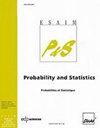用消失的平面波稳定逼近圆盘中的亥姆霍兹解
IF 0.7
4区 数学
Q4 STATISTICS & PROBABILITY
引用次数: 0
摘要
平面波的叠加可以很好地近似亥姆霍兹方程的解。它们在离散化中的应用是典型的用于亥姆霍兹问题的Trefftz方法,旨在以少量自由度实现高精度。然而,Trefftz方法会导致病态线性系统,并且在浮点运算中通常无法获得期望的精度。在本文中,我们证明了尽管必须求解这种病态系统,但明智地选择平面波可以确保以数值稳定的方式获得高精度解。平面波方法的数值精度不仅与近似空间有关,而且与平面波展开中系数的大小有关。我们表明,无论平面波的方向和数量如何,使用平面波可以导致指数大的系数,这导致数值不稳定。我们证明了所有的亥姆霍兹场都是倏逝平面波的连续叠加,即具有复传播矢量的与指数衰减相关的平面波,并证明了这导致有界表示。给出了一种用数值方法选择实值和复值传播向量集的构造方案。这导致了平面波的明确选择和相关的Trefftz方法,实现了准确性和稳定性。对二维圆形区域进行了理论分析。然而,这些原理是一般的,我们最后用一个数值实验证明了对多边形域的实际适用性。本文章由计算机程序翻译,如有差异,请以英文原文为准。
Stable approximation of Helmholtz solutions in the disk by evanescent plane waves
Superpositions of plane waves are known to approximate well the solutions of the Helmholtz equation. Their use in discretizations is typical of Trefftz methods for Helmholtz problems, aiming to achieve high accuracy with a small number of degrees of freedom. However, Trefftz methods lead to ill-conditioned linear systems, and it is often impossible to obtain the desired accuracy in floating-point arithmetic. In this paper we show that a judicious choice of plane waves can ensure high-accuracy solutions in a numerically stable way, in spite of having to solve such ill-conditioned systems. Numerical accuracy of plane wave methods is linked not only to the approximation space, but also to the size of the coefficients in the plane wave expansion. We show that the use of plane waves can lead to exponentially large coefficients, regardless of the orientations and the number of plane waves, and this causes numerical instability. We prove that all Helmholtz fields are continuous superposition of evanescent plane waves, i.e., plane waves with complex propagation vectors associated with exponential decay, and show that this leads to bounded representations. We provide a constructive scheme to select a set of real and complex-valued propagation vectors numerically. This results in an explicit selection of plane waves and an associated Trefftz method that achieves accuracy and stability. The theoretical analysis is provided for a two-dimensional domain with circular shape. However, the principles are general and we conclude the paper with a numerical experiment demonstrating practical applicability also for polygonal domains.
求助全文
通过发布文献求助,成功后即可免费获取论文全文。
去求助
来源期刊

Esaim-Probability and Statistics
STATISTICS & PROBABILITY-
CiteScore
1.00
自引率
0.00%
发文量
14
审稿时长
>12 weeks
期刊介绍:
The journal publishes original research and survey papers in the area of Probability and Statistics. It covers theoretical and practical aspects, in any field of these domains.
Of particular interest are methodological developments with application in other scientific areas, for example Biology and Genetics, Information Theory, Finance, Bioinformatics, Random structures and Random graphs, Econometrics, Physics.
Long papers are very welcome.
Indeed, we intend to develop the journal in the direction of applications and to open it to various fields where random mathematical modelling is important. In particular we will call (survey) papers in these areas, in order to make the random community aware of important problems of both theoretical and practical interest. We all know that many recent fascinating developments in Probability and Statistics are coming from "the outside" and we think that ESAIM: P&S should be a good entry point for such exchanges. Of course this does not mean that the journal will be only devoted to practical aspects.
 求助内容:
求助内容: 应助结果提醒方式:
应助结果提醒方式:


